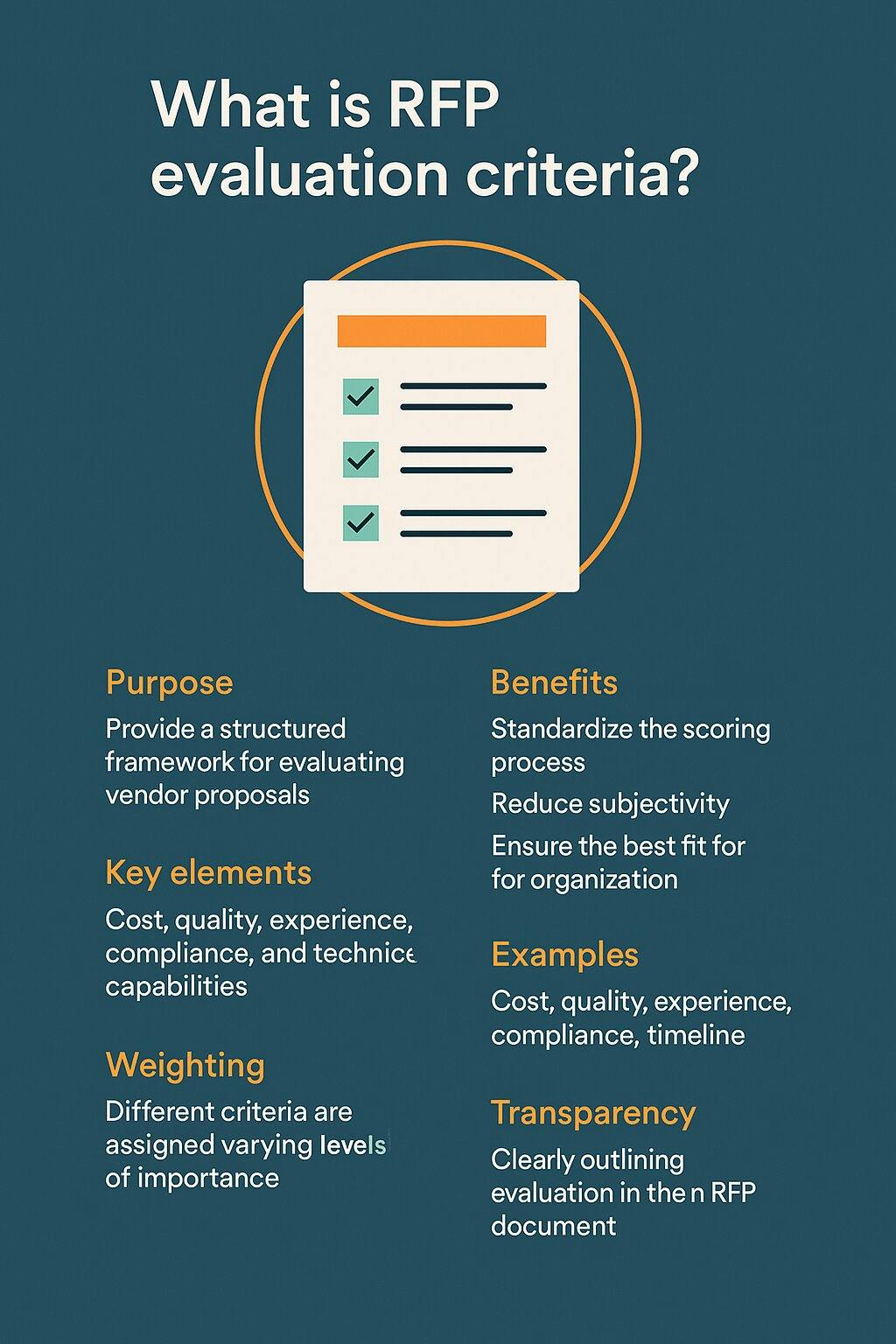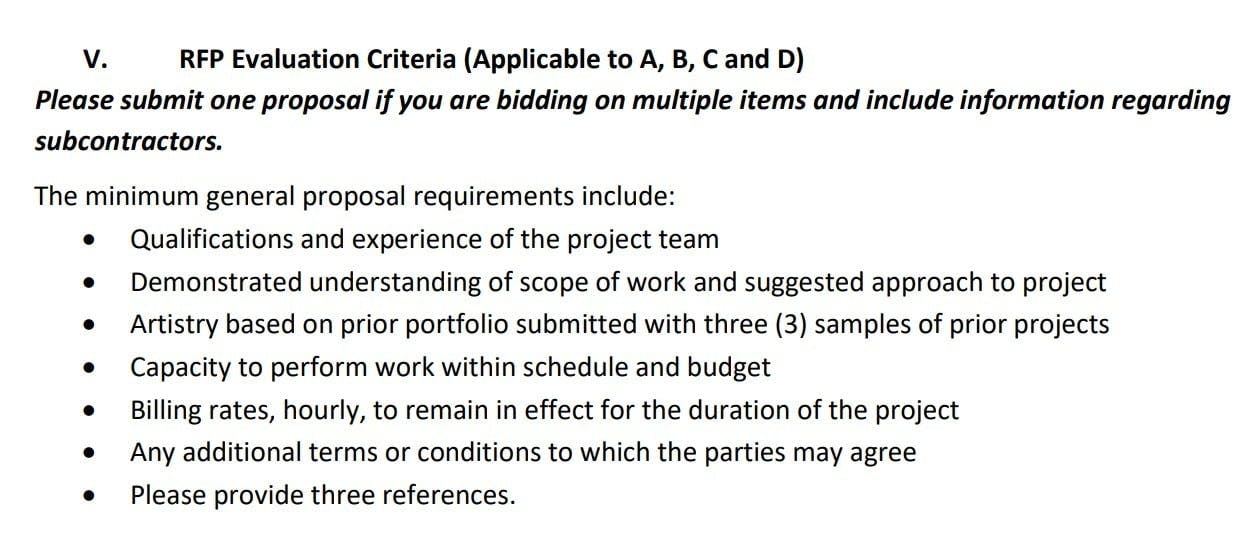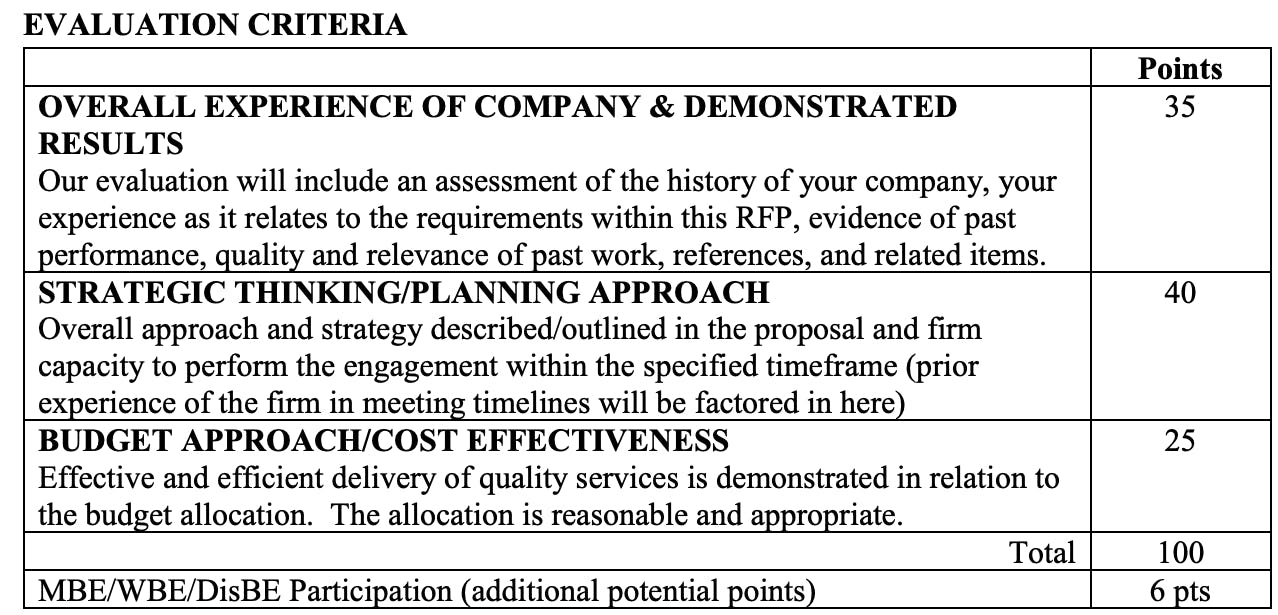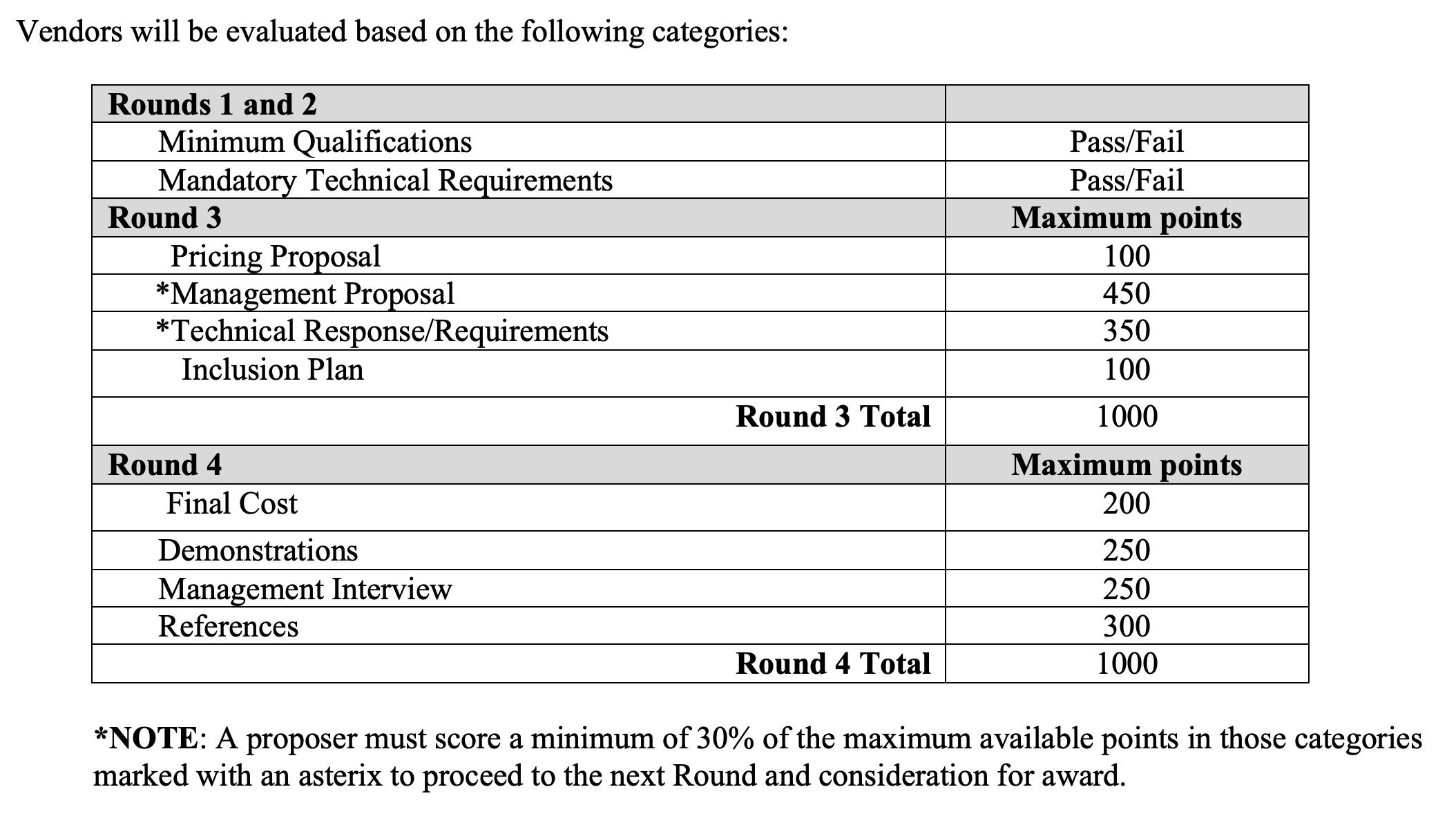When issuing an RFP, it’s important to create your RFP evaluation criteria early. In fact, it should be one of the very first steps in your RFP process. An RFP without evaluation criteria is like a ship without a rudder — it may eventually get to the destination, but the trip there will be meandering, time consuming and difficult. Clearly defining your RFP evaluation criteria gives your procurement project focus and direction.
In this blog, I’ll explore everything you need to know about RFP evaluation criteria. To start, I’ll provide an overview of the basics including the definition, strategies for organizing RFP criteria and a few real-world examples. Then, you’ll learn how to establish customized RFP criteria as a part of your RFP process. Finally, I’ll offer some best practices and tips to help you get started.
What is RFP evaluation criteria?
Request for proposal (RFP) evaluation criteria is a set of standards that guide the scoring of vendor proposals. When put into practice, your RFP evaluation criteria standardizes scoring and removes subjectivity from the process. Proposal issuers use criteria to organize the proposal evaluation process and select the right vendor for their procurement projects.

Generally, both internal and external teams receive the RFP evaluation criteria. Specifically, vendors review scoring criteria as a part of the RFP documentation. And, your internal stakeholders who will participate in RFP scoring use it as a reference document.
In addition to improving confidence in vendor selection, having clear evaluation criteria sets expectations, ensures high-quality RFP responses and delivers fairness and transparency to the process. Indeed, scoring guidelines help to guide vendors to focus on the issues and areas of the RFP that are most important to you.
Ways to organize your RFP evaluation criteria
As you might expect, the evaluation criteria will vary depending on the project at hand. So, you can create a standard RFP evaluation scoring guide, but you will need to use it as a template and update it for each project.
Simple evaluation criteria
The most straightforward approach to RFP evaluation criteria is a simple list. If your RFP project is a low-risk, simple purchase, you may not need to develop a complicated scoring system.
In this case, note your highest priority factors along with minor considerations in the introduction and background section of your RFP. Then, when you’re ready to score the proposals, remind your evaluators of the stated criteria. Finally, verify your results by comparing your selected supplier’s responses to the criteria.
RFP evaluation criteria matrix
One of the most popular ways to organize your scoring data is in an RFP evaluation criteria matrix. Often created in a spreadsheet, it can be as simple or complex as needed.
For example, a simple matrix lists criteria on the left hand side with the potential vendors along the top, allowing scorers to broadly evaluate and compare options. On the other hand, a detailed matrix breaks down scoring to the question level. This enables you to focus on detailed components and nuanced responses. Typically, strategic sourcing projects use detailed evaluation criteria matrixes.
RFP weighted scoring
The weighted scoring approach breaks down your RFP evaluation criteria and assigns a value to each question or section. For example, your RFP criteria may consider questions of technical expertise, capabilities, data security, HR policies and diversity and sustainability. Weighted scoring prioritizes the criteria that are most important to your business by assigning them a point or percentage value. So your weighted scoring criteria may look like this:
- Technical expertise – 25%
- Capabilities – 40%
- Data security – 10%
- HR policies – 10%
- Diversity and sustainability – 15%
A note about RFP evaluation: As you can imagine, managing RFP scoring in spreadsheets gets messy quickly. And, when it comes to complex strategic sourcing projects with more than three vendors, manual evaluation is time consuming. Consequently, the cost of procurement increases.
For many procurement teams, RFP software provides a solution. An RFP management system delivers efficiency with digital proposal responses, RFP automation and collaborative scoring.
RFP evaluation criteria examples
Admittedly, unless you see it in action, RFP evaluation criteria is hard to picture. So, the best way to understand it is to see it in practice. Below are examples of how evaluation criteria appears in an RFP.
Simple RFP criteria example – RFP for marketing services
The goal of this RFP is to find the best service provider for marketing services. In the RFP, the evaluation criteria appear in a simple bullet-pointed list.

Basic weighted scoring criteria example – RFP for employee benefits
This RFP evaluation criteria example is both weighted and fairly simple. Results are broken down into three main categories: experience, approach and budget.

Multi-factor RFP evaluation criteria – RFP for data analytics platform
This RFP breaks down the proposal scoring process into four rounds. Interestingly, the first two are pass/fail criteria that are deal breakers. This staggered evaluation helps vendors quickly understand if they will be eligible to win the business.

How to write RFP evaluation criteria
1. Determine requirements with stakeholders
The first step in your RFP process, after identifying a need, is to collect information from stakeholders and executives. Consider this your first draft of your RFP requirements discovery process.
To start, gather a list of requirements from those involved. It may help to provide a list of standard criteria for evaluation of RFP to start.
Sample RFP evaluation criteria:
- Technical capabilities
- Vendor experience
- Local vs. global
- Project approach
- Total price
- Customer success practices
- Reputation and customer references
- Social policies
- Data security
- Terms and conditions
Encourage them to brainstorm without considering budget (we’ll get to that later). Compile your list of possible features and capabilities and note which items were mentioned repeatedly.
2. Define project scope
Next, use your full list of considerations and narrow it down. Categorize each item into one of three categories: must have, nice to have and not needed. Then, use the results to write corresponding RFP questions. For must-have elements, try to ask close-ended questions. This makes objective evaluation easier.
Naturally, questions about these factors will be spread among different sections. So, as you build your RFP be sure to keep track of which are deal-breaker questions.
3. Establish RFP priorities
RFP evaluation is all about give and take. If you can get exactly what you want in one area, but must sacrifice in another how does that impact a vendor’s score? Your RFP criteria should communicate your priorities. The best way to do that is to establish values for the most important sections of your RFP. Often, we see capabilities and experience most heavily weighted. Surprisingly, in most cases, price isn’t the highest priority.
Best practices for RFP evaluation criteria
Be as transparent and upfront as possible
Vendors spend a great deal of time and energy creating proposals. Truly, they want to provide you compelling and relevant responses. However, they need to know what matters most to you. Therefore, the more you can tell them about your needs and priorities, the better responses you’ll get. Include your RFP evaluation criteria in the RFP as well as the weighting you plan to use.
Don’t deviate from your RFP criteria
Once established, your RFP evaluation criteria should be the foundation and guide to your scoring process. Of course, things happen, so if you need to update your criteria, also make sure vendors are aware.
For example, a vendor offers a service you didn’t consider, but after review believe is necessary. In this case, you should issue a follow up note to the other vendors and give them an opportunity to meet the new requirement. Not only does this give suppliers a fair playing field, but it also ensures you avoid potential risk and compliance issues.
Create an RFP evaluation guide
Some of the complexity of proposal evaluation comes from internal ambiguity around scoring expectations. To solve this challenge, it’s a good idea to create a short guide for your stakeholders to follow when scoring RFPs. Include the original list of considerations along with their assigned priority. If possible, provide explanations or context for subjective questions.
To help you get started, here are three examples of internal documentation for RFP evaluators.
- University of North Dakota RFP evaluators guide
- The University of Texas RFP evaluation guide
- Oakland County Michigan – RFP evaluation team handbook
Engage individual stakeholders
As with most complex procurement and strategic sourcing projects, the procurement manager running the RFP, may need help to evaluate vendor proposals. For example, if you are seeking a new employee benefits system, your HR team who will use the system should have input on which of the potential vendors delivers the most value.
I recommend engaging each stakeholder individually rather than as a group. It may seem like more work, but it’s worth it. Here’s why — in large groups, RFP evaluation tends to be influenced by the loudest voices or strongest opinions. Admittedly, manually scoring individual responses is tricky but automated scoring with an RFP management system makes it fast and easy.
Keep contributors focused
While I recommend individual stakeholder scoring, I also know that adding scorers draws out the RFP timeline. So, how do you strike a balance between involving the right people and a speedy conclusion?
The best way to avoid unnecessary bottlenecks and delays is to keep contributors focused. Consequently, that means only sending them the sections and questions that they need to score. Indeed, assign questions based on their area of expertise. For instance, using the employee benefits example from above, while your IT team may need to review and score the section about the provider’s data security, they don’t need to read responses about the fees involved in 401K accounts.
If you undertake this manually, you can send the questions via spreadsheet and compile the results. Alternatively, RFP software automates this process. Simply assign each section or question to the teams or individuals responsible for evaluating the response and monitor their progress. Then, the system records the scores, compiles and compares them and creates helpful visualizations.
Discuss discrepancies
In RFP evaluation, disagreement is normal. Scorers interpret questions differently and score them based on their own understanding. As you review individual scores, watch for any major discrepancies in evaluator scores. These differences may indicate a question that was unclear or misunderstood by the vendor or evaluator. Collaborate with the scorers and develop an understanding of the reason behind the different scores.
RFPs are designed to make vendor selection easier. Likewise, establishing RFP scoring criteria simplifies the process. The benefits of creating scoring criteria include keeping stakeholders involved, improving vendor engagement and ensuring transparency. Ultimately, it’s a key element to keep your RFP process running smoothly and efficiently.

